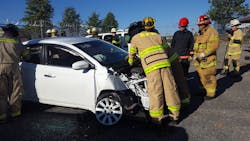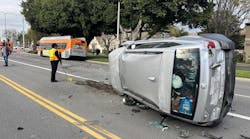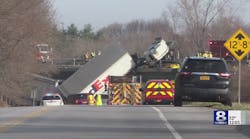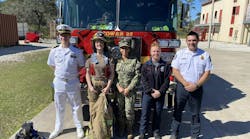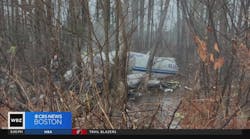Automobiles are getting safer and necessarily more complicated and challenging for firefighters and responders who are called to rescue people after crashes.
Firehouse Expo attendees learned from University of Extrication author Ron Moore about the latest in automotive technology and tricks of the rescue trade at an action packed day-long class that started at an auto impound yard in Nashville this morning.
“What I hope we'll go home with is fresh ideas, fresh techniques and a fresh understanding about auto extrication,” Moore said in an interview during a short break in the action. “I want them to take away knowledge they can share with the people back home in their departments. …I want them to become problem solvers.”
During his hands-on teaching, Moore pointed out features and hazards on a variety of vehicles, including a 2017 Acura SUV-style, four-door vehicle. Many of the features are designed to keep the occupants safe may become hazards to firefighters and first responders charged with saving victims after crashes.
For instance, Moore pointed out the gas cylinder for powering air bags in the A-post of a BMW, a place where rescuers typically cut for victim extrication.
“Wouldn’t you like to know that that cylinder is right there where you want to cut before you start working,” Moore said, pointing to logos and symbols that provide clues to what the rescuer is competing with during extrication.
Moore also pointed out that many late model cars now have ceiling mounted air bag and side curtains that remain inflated after the initial gas burst. That’s different than most older cars that have air bags that deflate after impact and deployment.
“Don’t be afraid of that,” Moore said, giving the inflated bag a “Charmin squeeze” illustrating that it remained inflated like a camping mattress. “You can cut any place on this and the whole thing will deflate. There’s no pressure in this that will harm us.
Moore said he hoped that the attendees would learn something they never heard about before that will help them do their jobs immediately.
And for Joe Day, deputy chief of the Minquadale Fire Company in New Castle, DE, was among the firefighters from all over the region and the country participating in the class.
“What I have learned in the first couple of hours has already exceeded my expectation,” Day said. “Ron Moore is an excellent teacher. You can tell he does this because he likes to do it.”
Moore said he goal is to make learning about extrication engaging.
“I hear from a lot of firefighters who say they do extrication, but it’s boring,” Moore said. “If extrication is boring, there’s a problem.”
One of the ways Moore engages his students is through organization. He runs the training scenarios like true incidents with a command post, teams and assignments.
“Extrication is not for freelancing,” Moore said, adding that there are tasks that must be accomplished for a successful extrication.
During one scenario, teams were asked to take off the front doors of the 2017 Acura.
“Stop, Stop,” Moore said as spreaders were tearing the driver’s door. “I want a strap on that so when it pops, it doesn’t go flying across the parking lot. …We’re professionals and we need to do things right.” A firefighter pulled out a web strap from his turnout gear and secured the door. “That’s good. That’s better,” Moore said.
For Moore, the mission is to provide education for his students that will help them do their jobs better for better outcomes for the people they serve and to keep themselves safe.
“For some of the local fire departments, what they learn here today, they can use tonight,” Moore said.
